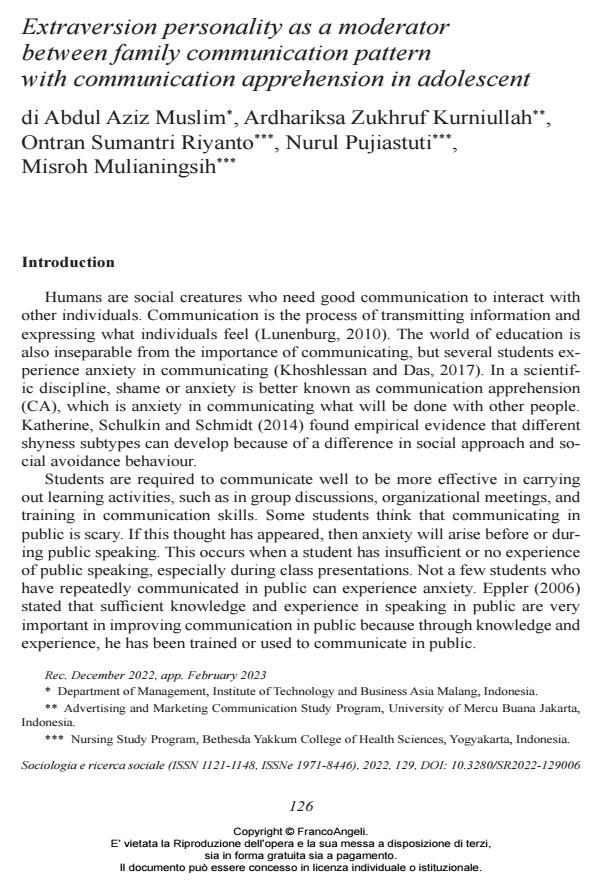Extraversion personality as a moderator between family communication pattern with communication apprehension in adolescent
Journal title SOCIOLOGIA E RICERCA SOCIALE
Author/s Abdul Aziz Muslim, Ardhariksa Zukhruf Kurniullah, Ontran Sumantri Riyanto, Nurul Pujiastuti, Misroh Mulianingsih
Publishing Year 2023 Issue 2022/129
Language English Pages 10 P. 126-135 File size 158 KB
DOI 10.3280/SR2022-129006
DOI is like a bar code for intellectual property: to have more infomation
click here
Below, you can see the article first page
If you want to buy this article in PDF format, you can do it, following the instructions to buy download credits

FrancoAngeli is member of Publishers International Linking Association, Inc (PILA), a not-for-profit association which run the CrossRef service enabling links to and from online scholarly content.
Humans are social creatures who need good communication to interact with other individuals. This study aims to understand the influence of family communication patterns (conversation and conformity) on communication apprehension moderated by the adolescent’s extraversion personality. An instrument is the Personal Report of Communication Apprehension (PRCA-24), Revised Family Communication Patterns Instrument (RFCP), and International Personality Item Pool (IPIP) NEO-120. The result showed that pattern of conversation has a negative effect (ß = -0.620, p = 0.000) and conformity has a positive effect (ß = 0.730, p = 0.008) on communication apprehension. Conversation orientation is a relationship between family members who emphasize freedom in expressing an opinion. Meanwhile, the application of conformity family communication patterns is more oriented toward children’s independence. Extraversion personality can decrease the influence of the communication patterns conversation and conformity to communication apprehension. Communication apprehension moderated by extraversion personality in the adolescent is influenced by the application of the conformity family communication pattern.
- Comparative Analysis of Regulations on IT-Based Money Lending and Borrowing Services in Indonesia and Vietnam Sri Mulyani, Le Ho Trung Hieu, Anggraeni Endah Kusumaningrum, Retno Mawarini Sukmariningsih, Ontran Sumantri Riyanto, in WSEAS TRANSACTIONS ON ENVIRONMENT AND DEVELOPMENT 66/2024 pp.689
DOI: 10.37394/232015.2024.20.66
Abdul Aziz Muslim, Ardhariksa Zukhruf Kurniullah, Ontran Sumantri Riyanto, Nurul Pujiastuti, Misroh Mulianingsih, Extraversion personality as a moderator between family communication pattern with communication apprehension in adolescent in "SOCIOLOGIA E RICERCA SOCIALE " 129/2022, pp 126-135, DOI: 10.3280/SR2022-129006